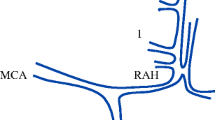Summary
A series of 17 patients was investigated following common carotid ligation. The period between operation and examination ranged from 2–7 years. Cerebral circulation was estimated by use of the rheoencephalographic method.
Statistical analysis of the reg plot was performed by comparing an age-matched normal population with patients. A comparison was also made of the ligated and nonligated sides for the patients. The following results were obtained: a significant decrease in the amplitude of the reg waves, an extension in the anacrotic part of the wave, and a decrease in the angle of its inclination. This was intensified more on the side of the common carotid ligation.
These findings may suggest that after common carotid ligation the cerebral circulation is changed for a long period of time. They would also seem to indicate that postoperatively, the cerebral circulation does not return to normal—if it ever does.
Similar content being viewed by others
References
Gelber BR, Sund TM (1980) Treatment of intracavernous and giant carotid aneurysms by combined internal carotid ligation and extra-to intracranial bypass. J Neurosurg 52: 1–10
Kak VK, Taylor AR, Gordon DS (1973) Proximal carotid ligation for internal carotid aneurysms. A long term follow up study. J Neurosurg 39: 503–513
Łebkowski J, Mariak Z, Borucki Z (1978) Rheoencephalographic evaluation of cerebral circulation after carotid artery ligation in cases of ruptured intracranial aneurysms. Neurol Neurochir Pol 12: 731–736
Mariak Z, Borucki Z (1980) Rheoencephalographic investigations in a group of 102 healthy subjects. Neurol Neurochir Pol 14: 134–139
Nornes H (1973) The role of the circle of Willis in graded occlusion of the internal carotid artery in man. Acta Neurochir (Wien) 28: 165–177
Pozzati AE, Fagioli L, Servadei F, Gaist G (1981) Effect of common carotid ligation on giant aneurysms of the internal carotid artery. Computerized tomography study. J Neurosurg 55: 527–531
Rossi P, Rosenbaum AE, Zingesser LH (1970) The fate of carotid artery after occlusion for treatment of aneurysm. Radiol 95: 567–575
Sommach FM, Shenkin HA (1966) Agiographic end-results of carotid ligation in the treatment of carotid aneurysm. J Neurosurg 24: 966–974
Tindall GT, Goree JA, Lee JF, Odom GL (1966) Effect of common carotid ligation on size of internal carotid aneurysms and distal intracarotid and retinal artery pressures. J Neurosurg 25: 503–511
Tytus JS, Reifel E, Spencer MP, Burnett LL, Hungerford LN (1970) Common carotid ligation for intracranial aneurysms: Results in 26 cases. J Neurosurg 32: 63–73
Author information
Authors and Affiliations
Rights and permissions
About this article
Cite this article
Mariak, Z., Lewko, J., Łebkowski, J. et al. Late rheoencephalographic assessment of the cerebral circulation after ligation of the common carotid artery. Acta neurochir 86, 30–32 (1987). https://doi.org/10.1007/BF01419501
Issue Date:
DOI: https://doi.org/10.1007/BF01419501




